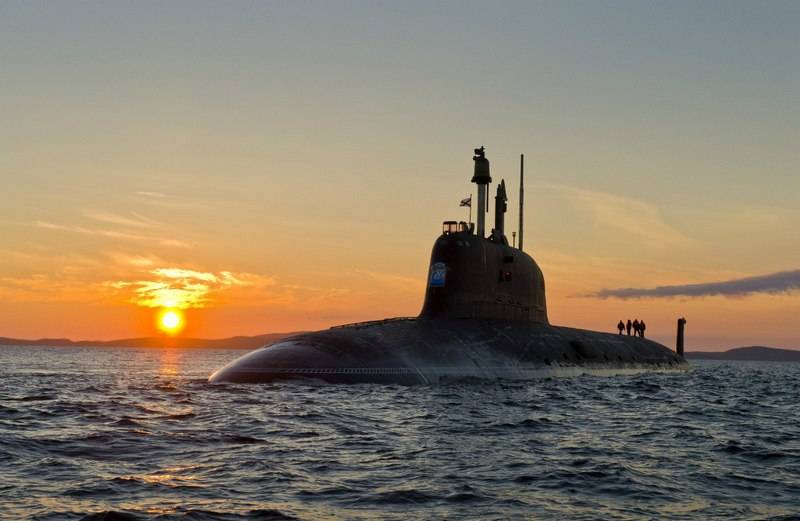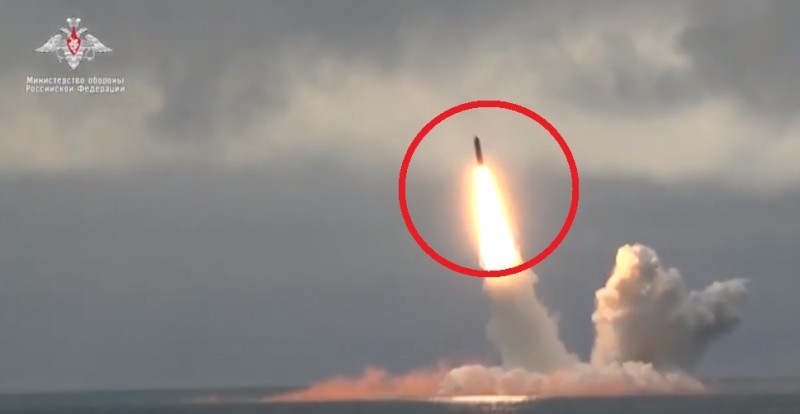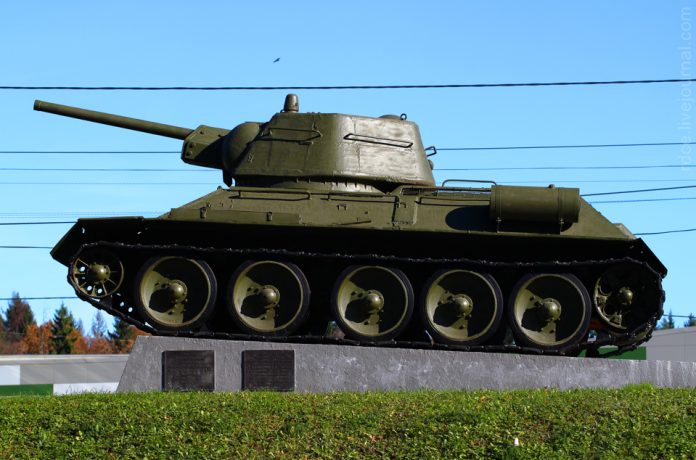
Unfortunately, In the last article "I am not got" the material on means to monitor the situation, which provides T-34, so with him and start.
Need to say, what T-34 the pre-war output and production of the first war years often (and absolutely deserved) reproach absence commander's cupola, providing a tank commander relatively good overview of the battlefield. Can I ask you a question, why our tanks are not staffed like turrets?
The thing is, what, According to Russian tank builders, function will execute the commander's turret Overview, on the principle of action reminiscent of a submarine periscope. Respectively, If the disposal of the commander of the German T-3 had five reticule slots in above the turret, and is a conventional slot armor, zabrannыe tripleksami, the commander of the T-34 features a panoramic unit PT-K, which in some cases replaced by a panoramic sight PT 4-7) and two periscope sight, located on the sides of the tower.
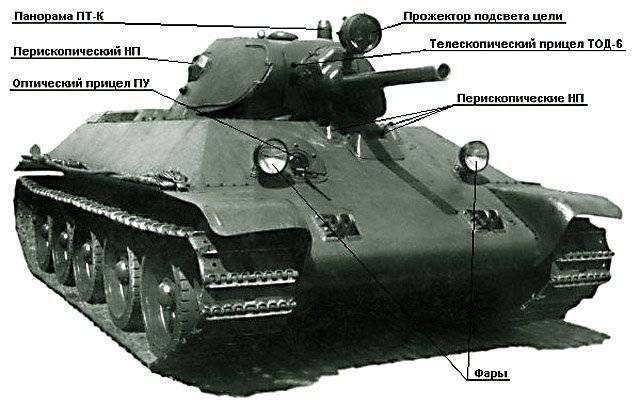 This scheme is taken from an article by Gregory Malyshev«fire control devices of the Soviet and German tanks of World War II. Myths and Reality» previously published on «IN».
This scheme is taken from an article by Gregory Malyshev«fire control devices of the Soviet and German tanks of World War II. Myths and Reality» previously published on «IN».
In this way, theoretically Commander T-34 was supposed to have an advantage over his German "colleague", but in practice it turned out to be a Russian tank "blind", while the German had a perfectly acceptable visibility. Why is that?
At first, it is an awkward situation and a small field of view from the panoramic sight. In him, trivially, it was hard to look from the commander's seat - I had to twist his head at an unnatural angle, and particularly this drawback occurs during movement of the tank. Theoretically, the PT-K could provide an overview on the 360 city., but actually it did so only 120 degrees to the right of the direction of movement T-34, thus it remained very much, not being viewed, "Dead" zone in the tank.
It should also be noted that, Some disadvantages of panoramic device PT-K resulted from its merits. So, he had 2,5 fold increase, which was very useful for, to detect camouflaged targets - By the way, such a possibility Commander T-3 was stripped, which it was considered a notable lack of German tank. But on the other side, this increase with a limited angle of visibility required from the commander T34 slowly rotate a circular handwheel actuator monitoring mechanism, otherwise the image spreads.
And so, as a result of the above,, German tank commander had a good opportunity at any time, shaking his head, to inspect the battlefield and identify the threats to its tank, while the commander of the T-34 was supposed to slowly inspect a limited sector of space in front of the right-his «iron horse»…
As for the side watchtowers devices, which possessed commander T34, then he had to bend down much, to look at the, which was located on his part. Author of this article and could not understand, Did the commander the opportunity to look to the left viewing device, is on the side loader, but the test results for both instruments and noted the inconvenience of use, and a small field of view, and the inability to clean glass devices, remaining inside the tank, and a significant dead space… Generally, despite the simplicity of review "devices" German tank T-3, his commanding officer could have much better control over the battlefield.
German tank gunner in addition, properly, sight, I had also 4 sight buttons gap, in this way, he could inspect the space next to the tank along with the commander. At the T-34 commander himself was a gunner, and as such, disposal, in addition to the above-described viewing means, also armored telescopic sight TOD-6.
Need to say, that structure our sights were quite perfect, Furthermore: Americans, studied T34 at Aberdeen Proving Ground, even concluded, his sight "by design the best in the world", but noted mediocre optics. As a matter of fact, this was the first major shortcoming of our sight in comparison with the German: basically, they provided the gunner comparable opportunities, but dressing lenses German instrument combining traditional high quality of German optics, while we have it was slightly worse than before the war, and at the initial period it was at some point all bad, during the evacuation of the plant producing it. Nevertheless, even in the worst of times, it was impossible to speak of the insane at the sight of Soviet tanks.
The second drawback is that, that German tank sights were, if you can put it there, "Turning point". That is the position of the part of the sight, which I looked gunner, It remained unchanged from the angle of elevation gun, but the gunner-commander of the T-34 was forced to bend over, or vice versa, lifted after sight TOD-6.
The driver at the T-34 had three periscopes and, properly, driver's hatch, which could open up. Mehvoda T-3 possessed a "periscope" and a reticle slit. But the German instrument provides a very good overview of the "forward-left", while the adjacent gunner, having at its disposal two sight buttons gap, I had a good overview of the "forward-right", why could suggest something driver-mechanic.
At the same time, three "periscope" T-34, our designers at different levels (front, looking forward periscope - 69 cm from the seat, left and right - 71 cm). Considering, that the difference in 2 cm in a sitting position require different growth, since the front periscope turned out at the level of the eyes mehvoda, if the latter was short, and the side - if the "below average", about any convenience of observation can not speak. Besides, on the side of the instrument no nalobnik, they are very dirty quickly when driving over the snow to the state of complete loss of sight, and staff "janitors" with their cleaning is not quite cope.
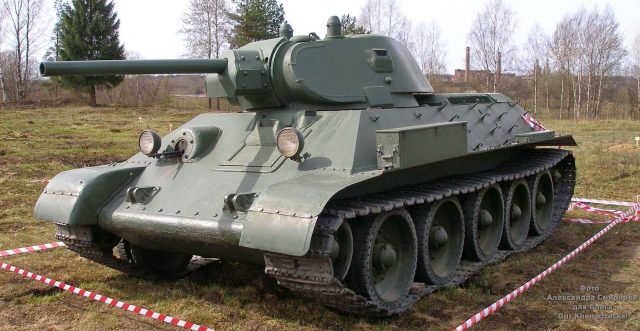 The photograph clearly visible all three «periscope» the driver
The photograph clearly visible all three «periscope» the driver
Not a good visibility of the driver in the T-34 (when closed hatch) supplemented blindness radio operator-gunner, who had only an optical sight for gun. In fact, he gave so meager viewing angle and was so uncomfortable, that almost did not allow conduct aimed fire from a machine gun in battle. From the memoirs of tankers should be, that gun in most cases acted as a "psychological" (We shoot in the wrong direction!), or removable arms.
Notwithstanding the foregoing, I would like to note the following. Of course, vision devices T 3 and T 4 provide the best overview, What was the T-34 release 1940-1942 gg., but it does not mean, German tank crews that have seen all, and our - nothing. Still, you need to understand, that the review of the tanks of those years, that the British, that German, that domestic or American was very poor. But the T-34 was worse, than the German tanks.
weaponry
Artillery. here, without any doubt, T-34 is leading by a wide margin, and from the German, and from any contemporary medium tanks of other powers. Equipping the latest Soviet medium tank 76,2 artsistemami mm L-11 and, later, F-34 with high enough to 1940 g. muzzle velocity, which constituted 612 and 655-662 m / s, respectively,, It was a huge step forward for the world of tank.
In fact, it was about, that it was the T-34 was a universal artillery systems, suitable for controlling almost all the possible objectives of the tank: enemy armored vehicles, field artillery, PTO, infantry, as well as a number of field fortifications. At the same time, the German tanks artvooruzhenii even at the beginning of the Great Patriotic persisted even known specialization. So, 37-mm and 50-mm guns, mounted on the T-3 due to the small weight of the projectile, and, respectively, small explosive content in it, not too well suited to defeat the infantry and artillery, and were for the most part antitank weapon.
Nevertheless, in the fight against tanks with domestic F-34 could argue perhaps that the best of them, long-barrel 50 mm gun KwK 39 L/60, whose armor was quite comparable with the Soviet gun. But, not having advantages over the F-34 on the part of combat armor, KwK 39 L / 60 conceded her on effects on other objectives type, and in addition, at the time of the invasion of the Soviet Union possessed such an instrument exactly 44 German tanks.
conversely, on the field fortifications, unarmored infantry and other objectives could be nice to operate artillery system KwK 37 L/24, installed on the T-4, but, Due to low muzzle velocity, is only 385 m / sec, it is much inferior and L-11, and F-34 to defeat the enemy armored opportunities. Perhaps, the only indisputable advantage of German armored artillery systems on the domestic A-11 and F-34 have been their relatively small size, leaves more room in the tower for other units and crew.
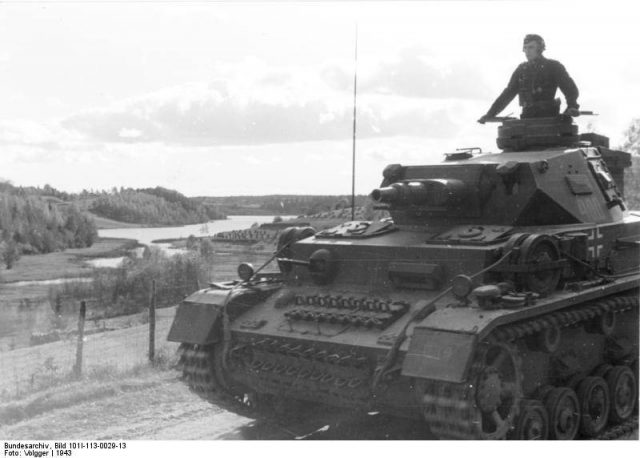
About other countries and say nothing - French 47-mm and 40-mm British gun F-34 categorically inferior in all respects. Other business - American M3 "Lee", received on the weapons 75 mm artillery systems are more or less comparable with domestic 76,2 mm as a weapon, but the Americans have managed to push it into the sponson with a very small angle of the horizontal guidance. As for the domestic F-34, the verdict of Americans, experiencing it on the Aberdeen Proving Ground, was that: "…very good. just, It runs smoothly and is easy to maintain ". The minus our cannon placed only a relatively low velocity of the projectile, that 1942 g was understandable.
Nevertheless, very high for 1940-1941 gg. The performance characteristics of our 76.2-mm guns to a certain extent leveled scanty number of armor-piercing shells, which for them has been able to make our industry. Apparently, the important role played by the, that there was no purpose for such shells for a long time - lightly armored tanks mid-30s could easily be destroyed even explosive 76.2-mm shell, or shrapnel, exposed to the contact action.
To 1937 g we produced 76.2-mm armor-piercing shell arr. 1933 city, and the rate of release does not dazzling: So, at 1936-37 gg. when the issue terms 80 000 shells failed to produce 29 600 meals. Considering, it needed not only in tank armor-piercing projectiles, but field guns, even planned figures look quite insignificant, and the actual output and does is vanishingly small value. Then, with the advent of more durable armor and tanks to develop protivosnaryadnym booking, It revealed, that the projectile arr. 1933 g. ineffective against armor plate thickness 60 mm, so I had to urgently develop a new.
However, the manufacture of armor-piercing shells were completely thwarted. When plans to launch in 1938-1940 gg. 450 000 shells, able to produce 45 100 shells. Only in 1941 g. He outlined, finally, breakthrough - at the plan in 400 000 shells at the beginning of June failed to produce 118 000 shells.
However, the scale of fighting 1941-1942 gg. and such issues were a drop in the sea. Eventually, even in July 1942 g. NII-48, studying the impact of domestic missiles on German armored vehicles, in the report "The defeat of the German tank armor" note:
«In view of the current lack of the required number of Kamorny armor-piercing shells in artillery divisions extended shooting at German tanks from 76.2-mm divisional cannon shells of other types of ...»
Not that, that could not in the Soviet Union to design the normal armor-piercing shell, problem was that, that the mass production of its required working of very high qualification, and these were in short supply. Eventually, even those shells, which is still produced by our industry, It was not so good, as they could be, but even they were few. To a certain extent the situation saved the decision to produce armor-piercing shells, blanks, contain no detonator and explosives in general. of course, zabronevoe effect of projectiles was insufficient, withdraw all the enemy tank could fail only if they enter into the engine, fuel tanks and ammunition.
But, on the other hand, you should not underestimate the capabilities of and discs shells. In the last article we described, that the T-34 could get quite serious damage, even in cases, when the projectile did not pass completely into the cabinet: damage is done to the pieces of tank armor, embossed shell "broneprobka" and the head of the projectile, which generally form or splinters fall into the space zabronevoe. In this case, it was about projectiles caliber 37-45 mm. At the same time, 76.2-mm steel blanks, according to the report NII-48, German tanks penetrated "from all directions" and, obviously, zabronevoe their effect was significantly higher.
Recall also that, what, with the growth of security tanks practically the whole world started to apply piercing projectiles, whose striking element, in fact, It was a small caliber steel ingot. Well, our T-34 shooting blanks caliber 76.2 mm, of course, zabronevoy effect «feeler» ammunition was much higher, than the piercing 50 and 75mm guns German.
Is another question - when we had such shells? The exact date of receipt of adopted "blanks" BR-350BSP author of this article, Unfortunately, Have not found, but A. Ulanov and D. Shein in his book "The order in armor?"mention 1942 year.
As for the machine-gun armament, to what, generally, it was sufficiently similar and our German tanks, including an on 2 machine gun "rifle" caliber 7,62 mm. A detailed comparison of guns and DT-34 MG, used in the Soviet T-34 and the German T-3 and T-4, perhaps, still beyond the scope of this article series.
Conclusions on the technical side
so, let's try to summarize now, told about the technical data of the T-34. Its armor protection was clearly superior to any medium tank in the world., but it was not a "not killed" - with big success of T-34 can be removed even 37-mm gun down, true, To do this, good luck in its calculation really had to be very, very much.
At the time of its introduction in the initial period of the Great Patriotic War T-34 with a full right to be called a tank with protivosnaryadnym booking, since it provided quite acceptable indicators of protection against the main tank and anti-tank guns of the German anti-tank guns. German tanks in 1941-42 gg. can "boast" such a level of reservation only in frontal projection. Protection of the T-34 has lost its "protivosnaryadnym" status only field adopting a 75-mm cannon Kw.k. 40, and it is on the German tanks appeared only in April 1942 city, and again, to be understood, that as a serious role she played even later, to the extent that, both appeared in the army in significant quantities.
Armament T-34 also surpassed their German "competitors", but the situation was complicated by the Soviet tank almost complete absence of proper armor-piercing shells. It made our tanks to approach the enemy to secure its defeat in the distance, where German tanks artillery system has had a chance to cause substantial damage to T-34.
Generally, if the T-34 were armed with full armor-piercing projectiles, then we, apparently, at the beginning of the war would have a "Russian" Tiger »», approach which the German tanks at a distance of at least certain number of effective fire their own guns could be deadly. Unfortunately, That did not happen, but because, not related to the structure of T-34.
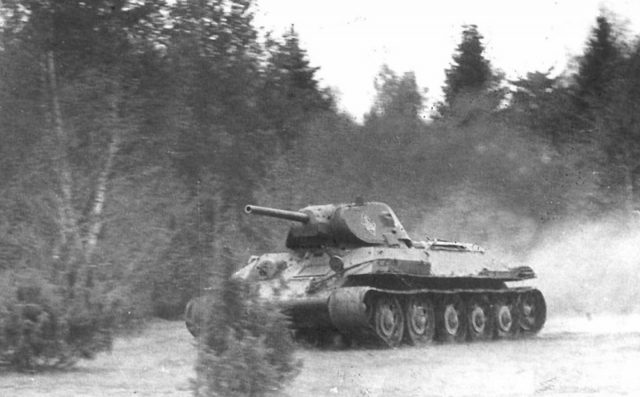
certainly, a large number of crew, due to which the commander was not necessary to combine the gunner, better working conditions and visibility were given certain advantages tankers, but that's as far as they were great? Perhaps, this question could be answered truthfully only tankers, I had the opportunity to make war on the Soviet, and captured German vehicles.
Today these deficiencies are often magnified, and can meet approval, they are collectively made T34 tank worthless, but there are other points of view. So, eg, D. Ordzhill, English journalist and writer, author of a number of books on military history and the development of armored vehicles, I wrote:
«All these shortcomings, but, were mostly insignificant.. They could play a significant role only if, if the tanks, which T-34 has met the battlefield, They were equal to him in a material respect».
Hard to tell, how right D. Ordzhill, but it should be noted, that he wrote during the Cold War, having no reason to flatter the military equipment USSR. Author of this Article, certainly, He understands the importance of ergonomics and good visibility in combat, but still suggests, that the Englishman is right in many respects and that the indicated shortcomings of the T-34 in terms of visibility and ergonomics still did not have a decisive influence on the losses of the “thirty-fours” in 1941-1942 gg.
Most likely, the key technical shortcomings were the complexity of managing the T-34 of pre-war and early military production and their relatively low technical reliability. Factors that contributed to this, as poor crew training and the not very successful disposition of our mechanized corps (MK), and all this together gave a cumulative effect. After all, what actually happened?
The location of the MK in the second and third echelons was theoretically the right decision, because it's from there, already after, how the directions of German attacks will be hidden, it would be best for them to advance for counterattacks. Placing MK in the first echelon would allow the Germans to surround them and deprive, thereby, combat mobility and power.
But in practice, this theory led to the fact, that our MKs had to advance and cover long distances in order to, to get in touch with the enemy. The crews of the T-34 for the most part did not have sufficient experience in driving these tanks, they saved on preparation due to the relatively low engine life of tanks. It got to that, mehvoda that the T-34 was taught to drive on other machines! Of course, it is better, than nothing, but such "preparation" to master the early T-34s with them a lot of nuances in management was impossible.
Technical shortcomings of gearboxes and clutches required increased professionalism of driver mechanics, and he, in fact, was downgraded. Besides, not everyone knew and were able to carry out the necessary preventive maintenance of components and assemblies in a timely manner, did not know the features of their technique. All this, obviously, could not lead to a mass exit T34 down for technical reasons before the contact with the enemy. So, eg, during the famous march of the 8th Mechanized Corps KOVO was lost 40 Tanks of the available 100, despite the fact that more 5 tanks at the start of the war were not functioning properly and had to leave in the place of permanent deployment.
Of course, on the same fact can be seen from the other side - yes, 8-Fourth MC lost 45% existing fleet of T-34, including 40% - on the march, but ... in the transfer under its own power by almost 500 km! Reading today's work impression, that the existing mechanized corps in the T-34 was bound to fall apart for spare parts after the first 200-250 km march, however, this has not happened. May be, not that it was bad for our machines with a resource, as it may seem at first sight ... or team eighth MK, Lt. Gen. Dmitry Ryabyshev still able to properly prepare their crews connection?
But, anyway, in conditions, when before the enemy had yet to reach (and, often, "Winding" at the same time more than one hundred kilometers), and even on the technique, requiring well-trained crews, but they are not, the larger non-combat losses are inevitable, by definition,. For strategic reasons, we have described in the first article in this series, The Soviet Union was doomed to lose the border battles, and it has absorbed the most combat-ready forces in the border districts.
Respectively, strategic initiative remained for the Germans, and they continued quite successfully started the offensive. this, in its turn, means, that derived from the system T-34 remained in the territory, captured enemy, even in those cases,, when they could easily be put into operation. There are cases, even when he had to kill a fully combat-ready tanks, who as a result of marches and battles left fuel and / or ammunition.
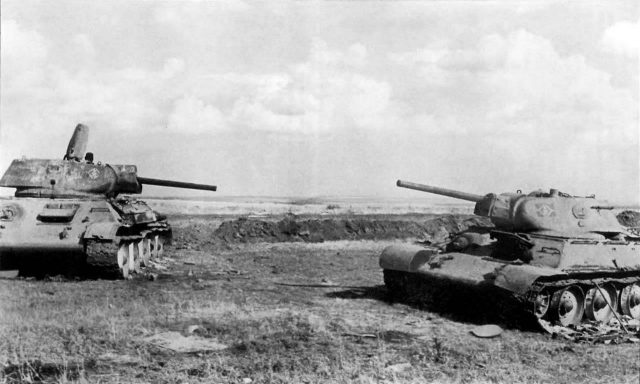
notoriously, that, ceteris paribus, in large tanks armed conflict bear the loss side, forced to retreat and lose its territory. Is that true and RKKA: So, in Moscow defensive operation, which lasted a little over two months, from 30 September 5 December 1941 g. we have lost a total of 2785 tanks of all types, or almost 1400 tanks per month, but one month of the Moscow offensive operations (5 December 1941 g - 7 January 1942 city) the loss amounted to only 429 machines, that is, the monthly average of more than three times less, than defensive (data and. Shmelev).
This is due to the fact, the tanks, lined on the battlefield, as well as the failed for technical reasons, remain with the, who comes, capturing (conquering) territory. Respectively, attacking side has the ability to introduce such tanks into operation, and backing - no. Retreating side can to some extent compensate forced abandonment and broken lined armored, but for this her armored units must be perfectly trained, and provided with the necessary number of tractors, Transport and t.d. Alas, Red Army tanks mehkorpusov, in contrast to the above, very often they had to engage in their own, in isolation is not the, that from the rear Mechanized Corps service, but even apart from their own infantry and artillery.
In this way, we conclude, that for technical reasons, significantly influenced the loss of T-34 in the initial period of war, It was relatively low reliability and demands on the qualification of the driver. And you can even say that, that due to the above reasons the T-34 pre-war output and the first war years did not meet the very concept, for which they were created. While the main task for these tanks in their design seen active steps in the operational area of the front of the enemy, that is, to a depth of 300 km., at 1940-1941 Mr. technically they were not ready for such operations. Respectively, they were not ready for that maneuver Tank War, which is forced upon us Wehrmacht.
Nevertheless, we have said previously, and repeat once again - the actual technical problems T-34 have not been any major, nor as something important among the reasons for the defeat of the Red Army armored troops in the initial stage of the war. Although, of course, they existed, of course, hinder fight, so in the next article we will look at the history of improving the design of the T-34 - and, simultaneously, changes in the structure of armored forces and the role of "Thirty" in the battle.
To be continued…
/Andrew from Chelyabinsk, topwar.ru/








